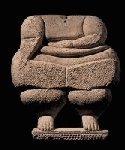

STONE AGE
BUILDING INDEX
STONE AGE
BUILDING
STANDING
STONES
NEWGRANGE
STONEHENGE
MALTA'S
MEGALITHIC
MARVELS
introduction
timeline
temple sites
ggantjia
hager qim
mnajdra
hypogeum
tarxien
magna mater
magna mater-myth
gallery
SKARA BRAE
Introduction
Megalithic marvels?
Now, what are these 'megalithic marvels' on Malta?
They're stone buildings, very old and very big stones which form impressing monuments. They were made by an ancient society, well advanced for their time. Malta's temples are proven to be the oldest stone buildings on the planet yet. Reason enough for Unesco to put these temples on the list of World Heritage list.
The brief description of Unesco says:
 "Seven megalithic temples are to be found on the islands of Malta and Gozo, each a result of an individual development. The Ggantija complex on the island of Gozo is remarkable for its superhuman achievements dating from the Bronze Age. On the island of Malta, the temples of Hagar Qin, Mnajdra and Tarxien are unique architectural masterpieces, given the very limited resources of their builders. [...] The Committee decided to extend the existing cultural property, the Temple of Ggantija, to include the five prehistoric temples situated on the islands of Malta and Gozo and to rename the site as 'The Megalithic Temples of Malta'."
"Seven megalithic temples are to be found on the islands of Malta and Gozo, each a result of an individual development. The Ggantija complex on the island of Gozo is remarkable for its superhuman achievements dating from the Bronze Age. On the island of Malta, the temples of Hagar Qin, Mnajdra and Tarxien are unique architectural masterpieces, given the very limited resources of their builders. [...] The Committee decided to extend the existing cultural property, the Temple of Ggantija, to include the five prehistoric temples situated on the islands of Malta and Gozo and to rename the site as 'The Megalithic Temples of Malta'."
 At around 4000 BCE ancient people started moving huge blocks of stones into great architectured buildings. The precision is perfect, especially for stone age people. Who these people were, where they came from and how they managed to create such imperssive building with almost no tools will probably always be a mystery. The artefacts they left behind show us they shared the same religion: they worshipped the Great Mother (Magna Mater) and as there is no evidence of weapons and defence walls we can assume that they had where we all long for in our days: a peaceful society.
At around 4000 BCE ancient people started moving huge blocks of stones into great architectured buildings. The precision is perfect, especially for stone age people. Who these people were, where they came from and how they managed to create such imperssive building with almost no tools will probably always be a mystery. The artefacts they left behind show us they shared the same religion: they worshipped the Great Mother (Magna Mater) and as there is no evidence of weapons and defence walls we can assume that they had where we all long for in our days: a peaceful society.
Prehistory
The story of these people start on the Maltese islands around 7000 BCE. It was then that humans crossed the Mediterranean from nearby Sicily and settled on the islands: Malta's neolithic history was about to start...
The New Stone Age period had three phases which succeeded each other without any interruptions. They are called: Ghar Dalam, Grey Skorba and Red Skorba. All these periods were named after sites, which have been excavated and left usefull information for archeologists.
After this the Temple Period started about 4100 BCE (over 6000 years ago!) and the first phase was 'Zebbug' (4100 - 3800 BCE). In this time a new group of farmers arrived at Malta, who had connections with the San Cono-Piano Notaro cultures in Sicily. However, still no temples were to be build, as there was none in the second phase: Mgarr (3800 - 3600 BCE). But then the Ggantija phase (3600 - 3300 BCE) came to Malta and finally the temple period earned its name.
NEWGRANGE STONEHENGE MALTA'S MEGALITHIC MARVELS SKARA BRAE
